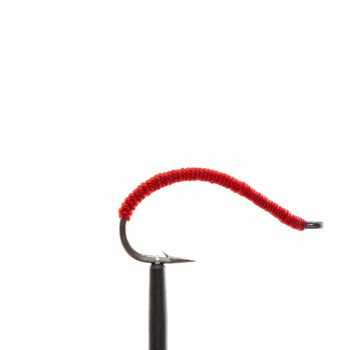How to Use a San Juan Worm

Consistently consistent...but great after rain and in high water.
Worm patterns are a versatile and effective staple in the fly fishing world, usable year-round but most effective after heavy rains or in higher water conditions. Common choices like the San Juan Worm, Ultra Worm, and the Sparkle Worm are designed to mimic aquatic worms often found in trout waters. These patterns are particularly valuable in spring, when runoff scours stream banks and fills rivers with natural worms.
In most scenarios, it's advisable to position your selected worm pattern—be it the San Juan Worm, the intricately designed Ultra Worm, or the eye-catching Sparkle Worm—as the primary nymph in a tandem nymph rig. This setup not only boosts your chances of a successful catch but also emulates the natural movement of worms in the water, making it an irresistible target for trout.
Adapting your rig for varying water conditions can significantly enhance your success. In deeper and faster-flowing waters, modifying your rig to ensure your worm pattern reaches the optimal depth is crucial. This might involve adding weight to your rig or, for a more streamlined approach, opting for beaded versions of the Ultra Worm or Sparkle Worm. These beaded variants not only sink more efficiently but also capture light, attracting the attention of curious trout.
HOW TO FISH A SAN JUAN WORM
To effectively use the San Juan Worm, adopt a slow, deep, dead-drift approach along seams and runs, much like you would with other nymphs. Don't limit yourself to just the edges of banks or boulders. Aquatic worms naturally inhabit the river's plant life, so getting your fly as close to the riverbed as possible increases your chances of a catch. Adaptability is key – match the worm's color and size to the water you're fishing in. The versatility of the San Juan Worm not only makes it a reliable choice but also adds a fun dimension to your fishing experience.
Setting Up Your Tandem Nymph Rig
Here's a simple guide to setting up an effective tandem nymph rig:
- Leader With A Strike Indicator: This is your starting point.
- Split-Shot Weights: Position these just above the knot connecting the first section of tippet to your leader. This placement prevents sliding and maintains the desired depth.
- First Tippet: Connects to the leader.
- San Juan Worm: Your primary nymph.
- Second Tippet: Attach this to the San Juan Worm. You have two options here: connect to the hook shank for a standard setup, or for added movement, tie it through the hook’s eye.
- Trailing Nymph: This could be another nymph or, for the adventurous, a second San Juan Worm!
For those looking to refine their technique with the San Juan Worm, advanced tactics can make a significant difference in challenging fishing conditions. One effective method is the "lift and settle" technique, which involves gently lifting the rod tip to raise the worm in the water column, then allowing it to settle back down. This mimics the natural movement of worms as they get dislodged and settle on the riverbed, which can trigger strikes from trout conditioned to this pattern of movement.
Additionally, consider adjusting your presentation based on water clarity and flow. In murky conditions, using a brightly colored or larger San Juan Worm can make your fly more visible to trout. Conversely, in clear water, a more subtle approach with smaller, natural-colored worms might be more successful. Employing a slight twitch to the rod tip occasionally can also add a dynamic element to the worm's motion, simulating a live worm struggling against the water flow.
Understanding and anticipating where trout are likely to feed is also crucial. During high water periods, trout often position themselves closer to the bank to escape the strong current and wait for food, making the edges along undercut banks particularly productive areas for deploying the San Juan Worm. By combining these advanced techniques with the standard slow, deep, dead-drift approach, anglers can enhance their effectiveness when fishing with this versatile nymph.
Expanding your worm pattern selection can significantly enhance your fly fishing arsenal, particularly when targeting selective trout. Here are some varied patterns to consider, each with unique attributes that can be game-changers under different fishing conditions:













